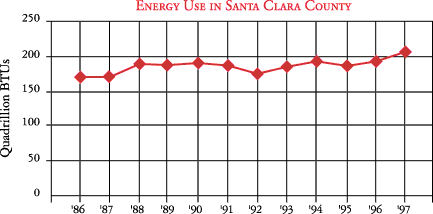
Energy use jumps 20% over 11 years, despite stable per-capita energy consumption
Why Is This Important?
There are no environmentally benign energy sources, except energy conservation. For example, burning fossil fuels such as coal, oil, gasoline and natural gas produces air pollution and creates carbon dioxide, a significant "greenhouse gas" contributor. Nuclear energy creates long-lasting radioactive waste as a byproduct. And hydroelectric energy usually results in the destruction of habitat. Even renewable energy sources such as wind and solar have environmental impacts.
Inherent in the concept of sustainability is the conservation of energy and a shift from higher to lower environmental impact energy sources.

How Are We Doing?
Total energy use in Santa Clara County climbed 20% since 1986. Since per-capita energy consumption has remained relatively constant since 1986, the increase in energy use is likely attributable to population growth, increased vehicle miles traveled per person, and/or increased economic activity.
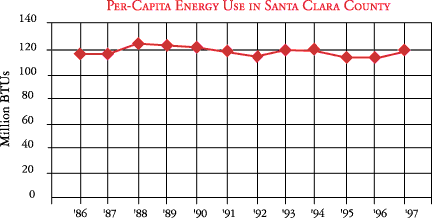
Data Sources: California Energy Commission
and California Department of Transportation
Why Is This Important?
Moving toward sustainability will entail preserving open space and protecting and restoring natural habitats and water resources. With increasing pressures from a growing population, sustainability will also require that we use existing urban land more efficiently to avoid urban sprawl. We can greatly enhance local sustainability by incorporating alternative forms of development which reduce impervious surfaces, reduce surface water and groundwater pollution, and preserve natural features of the land.
How Are We Doing?
Slightly more than one-fifth of the land in Santa Clara County is urban, up 4.1% since 1984. However, we are using urban land more efficiently, with the density of urban land use increasing from 8.06 people per acre of urban land in 1984 to 9.48 people per acre in 1998.
Almost half of our land is suitable for grazing, while less than 6% is used for non-grazing agriculture. About a quarter of our land is used for other purposes, including open space that is restricted from agriculture and grazing. In 1998 25% of Silicon Valley and its perimeter was permanently protected open space.
Why Is This Important?
How Are We Doing?
Per-capita water use (growing at an average of 1.90% per year since 1991) is increasing more slowly than total County-wide water use (which is growing at an average of 3.45% per year since 1991). This suggests that population growth and/or economic activity are driving the trend toward increased water consumption in the County.
Per-capita water use was 188 gallons per
day in 1998.
Currently less than 1% of water use is recycled water. Recycled water is mainly used for irrigation and construction purposes.
In Santa Clara County, residents account for more than half of water use, the majority of which is used to water lawns and gardens and for toilets. Almost one-third of the County's water use is for businesses and industry, with agriculture and public uses accounting for less than 10% each.
Why Is This Important?
In 1989, California passed the Integrated Waste Management Act (AB 939), which requires municipalities to cut waste in half by the year 2000. Achieving this goal entails reducing consumption, reusing materials, recycling, composting, and buying products made from recycled material.
How Are We Doing?
Even though total tons disposed has dropped by 17% since 1987, the County is estimated to be diverting 44% of its waste for purposes of measuring progress toward the state law requiring a 50% cut in waste. This means that 44% more waste would have been disposed in 1998 (taking into
account population growth and economic expansion)
without the reductions achieved by local waste
prevention and recycling programs.
Website developed by Clary Meuser Research Associates
![]()
Urban Land Use Expands, But Valley Using Urban Land More Efficiently
The way humans use land has a profound impact on ecosystems and species as well as our ability to grow our food locally, preserve open space, and protect water supplies. Modern forms of urban development such as roads, parking lots, and buildings destroy habitats and farmland and induce urban runoff pollution.
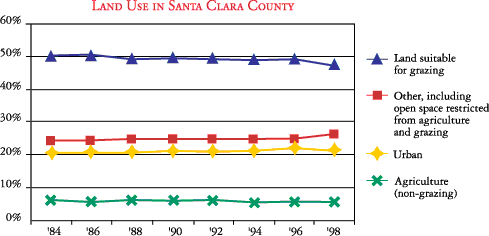
Data Source: California Department of Conservation, Division of
Land Resource Protection, Farmland Mapping and Monitoring Program
Historically our region was rich in a variety of habitat types and plant and animal life. With our fertile soil and diverse micro-climates, much of the land was converted to agricultural uses after the Gold Rush. At the time, the Santa Clara Valley was known as the "Valley of Hearts Delight" for its cloak of fragrant and beautiful orchards. Since then, much of the farmland has been developed for urban uses. Santa Clara County has recently been added to the California Department of Conservation's top 10 urbanization list, which ranks counties based on the amount of agricultural land lost to development.
South Bay Sprawl: 1850 - 1996
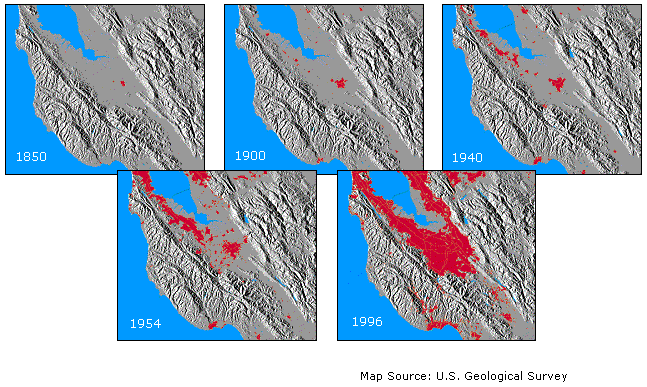
![]()
Water Use, After Trending Downward, Increases to Near Pre-Drought Levels
Water sustains life. Humans use it in a myriad of ways - for drinking, home use, landscaping, business, agriculture, recreation, and wildlife. A limited resource, more than half of Santa Clara County's water is imported from other parts of the state. As our region's population grows and the economy expands, there will be increased demands on limited water supplies. Long-term sustainability will entail using and reusing water efficiently so that water supplies are not depleted faster than they can be restored by nature.
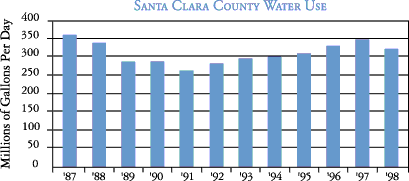
The drought and the economic downturn during the early 1990s drove a 27% decrease in Santa Clara County's water use from 1987 to 1991. However, once drought conditions and the economic recession eased, the County began a general upward trend in water consumption, with a 34% increase from 1991 to 1997. Water use dropped 8% in 1998 due in part to unusually wet weather early in the year, which helped reduce demand for water used in agriculture and landscaping.
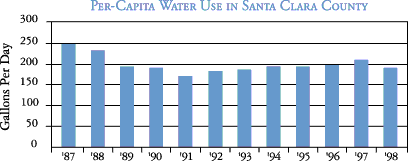
Data Source: Santa Clara Valley Water District
![]()
Waste Reduction Progress is Threatened by Increases in Waste Disposal
Disposed products were originally made from raw materials, which were extracted from natural resources. Long-term sustainability requires that we use natural resources no faster than they can be renewed, and to generate waste no faster than it can be naturally broken down and assimilated by nature.
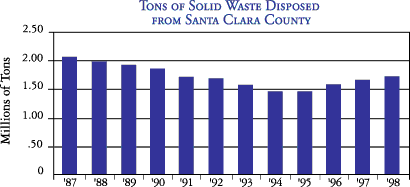
Santa Clara County has reduced its annual disposal tonnage by 17% since 1987, sending about 357,500 fewer tons to the landfill than 11 years ago. However, total tons disposed has been increasing since 1994 due to population growth and increased economic activity. In 1998 one ton of solid waste was disposed for each person in Santa Clara County, down from 1.44 tons per person in 1987.
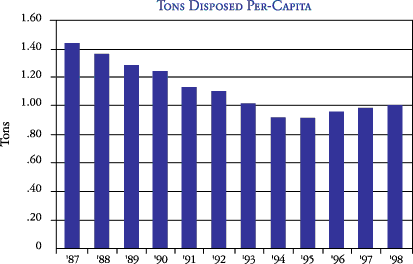
Data Source: Santa Clara County Integrated Waste Management Program
Copyright � 1999, Silicon Valley Environmental Partnership
All Rights Reserved